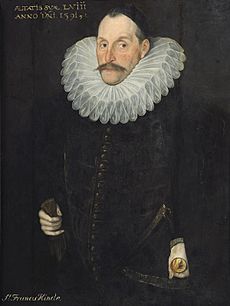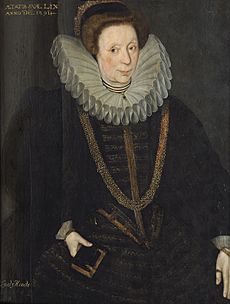Francis Hynde facts for kids
Sir Francis Hynde (born around 1532 – died 21 March 1596) was an important English politician and landowner. He lived in Madingley, Cambridgeshire, and also in Aldgate, London. He is especially known for developing Madingley Hall and its surrounding estates.
Contents
Family Life
Francis Hynde was the son of Sir John Hynde, who was also a Member of Parliament (MP). His mother was Ursula, daughter of John Curson. Francis went to St John's College at the University of Cambridge in 1546. Later, he studied law at Gray's Inn in 1549. His younger brother, Thomas, also attended the same college and law school.
Francis married Jane Verney. She was the daughter of Sir Ralph Verney from Pendley Manor in Buckinghamshire. Lady Jane Hynde had several siblings. Her brother, Francis Verney, was involved in a plot in 1556. Francis and Jane Hynde had an elder son named William Hynde, who also became an MP.
Sir Francis Hynde's Career
Land and Madingley Hall Development
Francis Hynde's father, Sir John Hynde, started buying land in Madingley, Cambridgeshire, in the 1520s. He bought two important estates called Burlewas and Marhams. By the time Sir John died in 1550, these estates were combined. Francis Hynde inherited them in 1551.
Sir Francis continued building Madingley Hall. His father had started the work. Around 1588–1591, Sir Francis added a new north wing. This part included a beautiful arched walkway (called a loggia) on the ground floor. Above it was a very long room, 87 feet long, called a long gallery. This gallery was placed between two tall towers.
It's thought that Sir Francis used stones from the old St Etheldreda church in Histon for his building work. This church was taken down around that time. His father had bought the land where the church stood in 1550. There's a story that the ghost of Sir Francis's mother, Lady Ursula Hynde, haunts Madingley Hall. People say she is sad about the church being taken down. However, Lady Ursula died in 1555, so her sadness would have been after her death.
Political Roles and Public Service
In March 1555, Francis Hynde was suspected of being part of a plot in Suffolk. He was held by Sir Giles Alington and was not fully released until 1559.
Francis Hynde first became a Member of Parliament (MP) for Cambridgeshire in 1559. He was chosen three times to be the High Sheriff of Cambridgeshire and Huntingdonshire. This important role meant he was the chief law enforcement officer for the counties. He served in 1561–62, 1570–71, and 1589–90. He was elected as an MP for Cambridgeshire again in 1572 and 1589. He often shared this role with other important people, including his relatives.
Sir Francis was knighted in 1578. This meant he received the title "Sir." Between 1582 and 1589, he bought another three hundred acres of land in Madingley.
Dealings with Corpus Christi College
Sir Francis Hynde had several dealings with Corpus Christi College. For a while, he had a disagreement with the College over land in Barton, Coton, and Whitwell. This led to a legal case that was eventually settled. He also held back an annual payment of 50 shillings that was owed from the Manor of Girton. The College's Master, Matthew Parker, eventually got this money back with help from Sir Nicholas Bacon.
In 1570, Francis and his younger brother Thomas sold some land and church rights in Little Wilbraham to the College for £830. In 1587, the College bought more land from Sir Francis in Stow-cum-Quy. Two of Sir Francis's sons also studied at Corpus Christi College in the early 1570s.
Land Disputes in Cottenham
Sir Francis also owned land in Cottenham. He changed how some of the shared village land (common land) was used. This caused long-lasting problems and disagreements with the local villagers. When he died in 1596, he did not leave a will. So, his son William, who inherited his father's estates, had to deal with these land issues. Several Cambridge Colleges also had interests in these lands.
Sir Francis Hynde passed away on 21 March 1596 at Madingley, at the age of 65. He had a special funeral at Madingley church. Lady Jane Hynde died later in Chelsea in 1607 or 1608. She was buried there on February 23. After William died in 1606, his wife married Sir Arthur Capell. She then managed the Madingley farmlands until her death in 1626. She rented out Madingley Hall to William's brother Edward starting in 1611.
Children of Sir Francis and Lady Jane Hynde
Sir Francis Hynde and Lady Jane (née Verney) had several children:
- Sir William Hynde (died 1606) was their eldest son and heir. He also became an MP. He married Elizabeth Wentworth first, and then Elizabeth Laurence. William studied at Queens' College in 1572 and was knighted in 1603. He did not have any children.
- Sir Edward Hynde (died around 1632) studied at Corpus Christi College in 1571. He married Alice Billett and later Mary Norton. He then married Barbara Powell. After his brother William died, Edward inherited his father's estates. He was knighted in 1615.
- John Hynde also studied at Corpus Christi College in 1571. He died without having any children.
- Jane Hynde (died 1633) married three times. Her last husband was Edward Radclyffe.
- Ursula Hynde married John Machell. He was a Justice of the Peace. Ursula's marriage settlement was secured by a loan from her father, Sir Francis Hynde.



